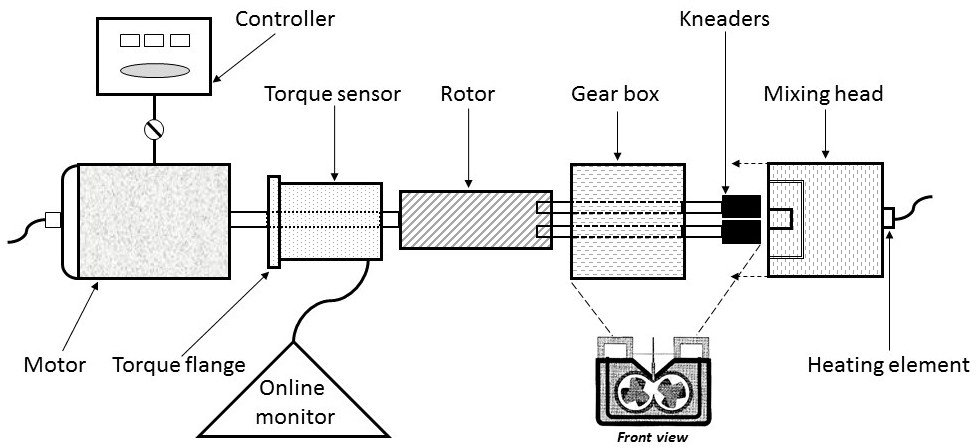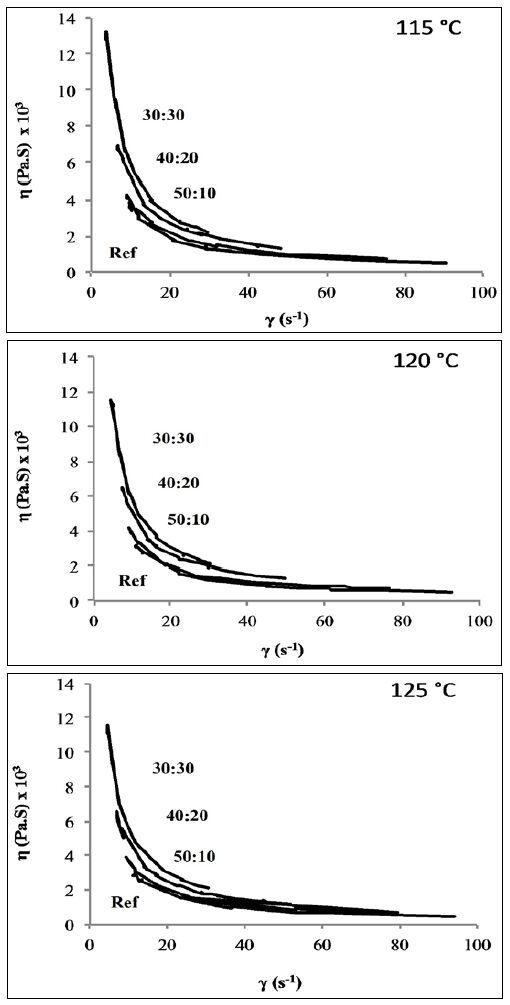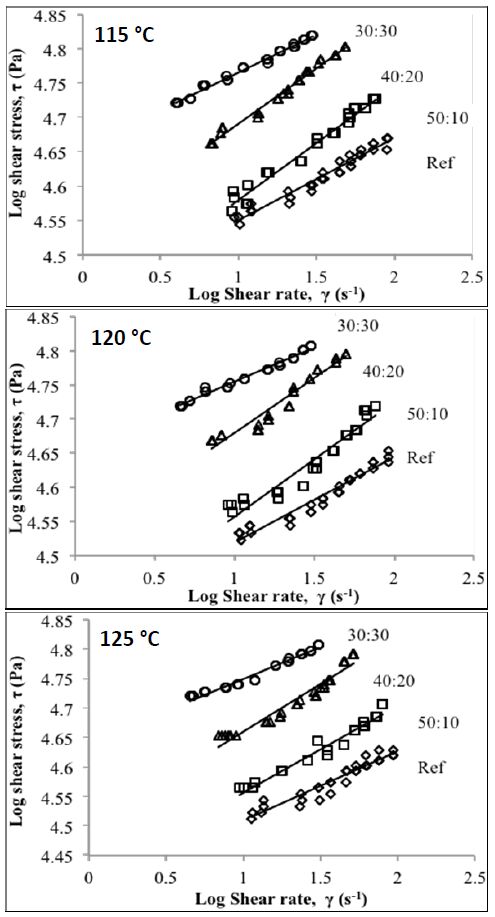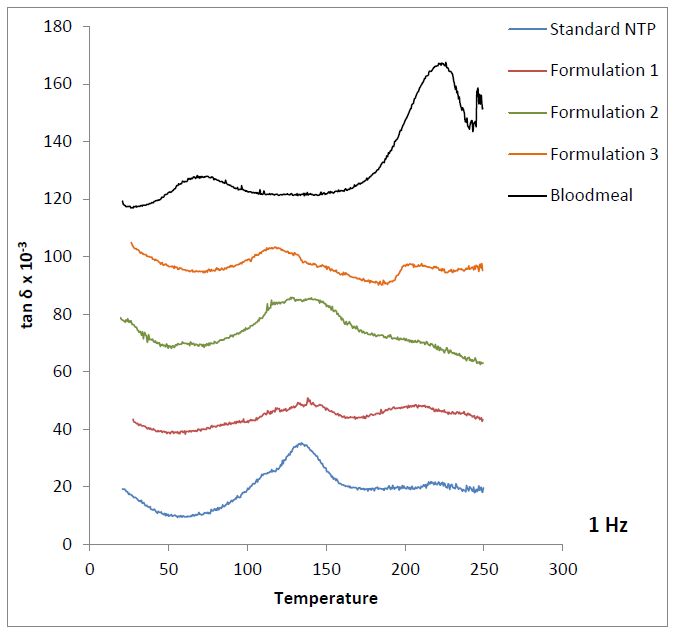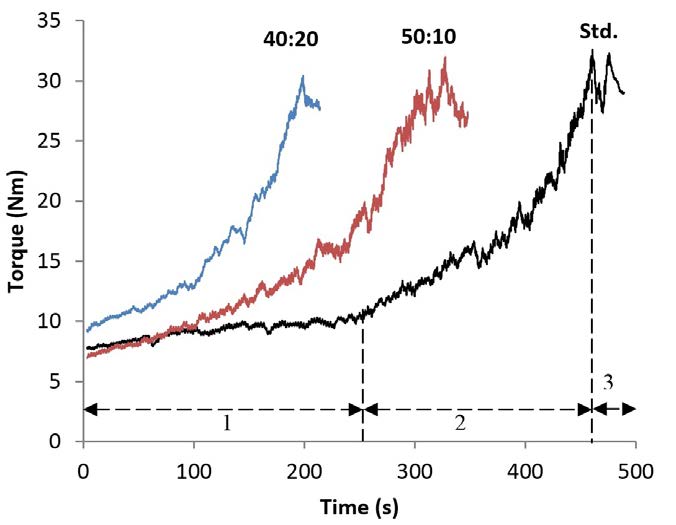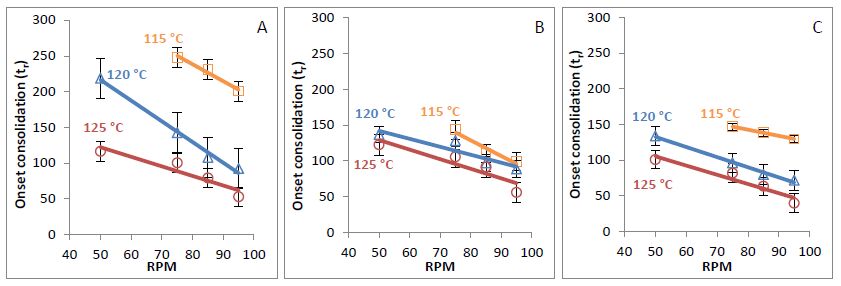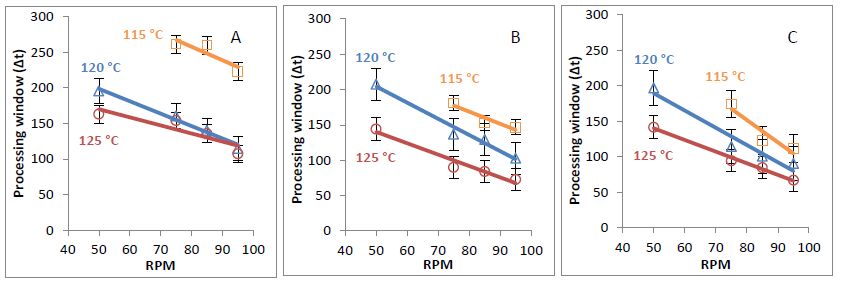1. Introduction
The past few decades have seen renewed interest in protein-based bioplastics from plant and animal sources, coinciding with an awareness of sustainability [1,2]. More recently, it has been shown that bloodmeal can be converted in to a thermoplastic polymer by mixing it with a reducing agent, protein denaturant, surfactant and plasticiser [3]. This material can be used in single-use situations, such as seedling trays and has been commercialised as NovateinTM thermoplastic protein (NTP).
Knowledge of the rheology of NTP is required to assess processability and to optimise process design. The rheology of NTP has not been studied before and can be done by either using capillary rheometry or using batch mixing at different shear rates. These measurements can provide additional understanding of the behaviour of NTP during injection moulding. It has already been shown that injection moulding parameters are important to optimise the mechanical properties of NTP [4], but further optimisation would require a thorough understanding of the material’s rheology.
Shear thinning, visco-elastic behaviour has been seen in soy-protein blended with corn starch, gluten-based plastics, whey protein, sun flour and oat proteins [5,6,7,8,9]. As expected, increased temperature [5] tends to decrease viscosity as well as the presence of reducing agents such as sodium sulphite [9]. In oat-protein systems, crosslinking the protein stiffened the backbone, reduced its mobility, thereby increasing its viscosity [7]. To control or reduce glass transition temperature (Tg) in polymers, plasticisers are added during processing [10]. For bloodmeal-based thermoplastics, water and tri-ethylene glycol (TEG) has been shown to be effective plasticisers [11], reducing viscosity and also facilitating the action of other additives [10]. Plasticisers tend to reduce intermolecular interactions such as hydrogen bonding, van der Waals forces, hydrophobic interactions and ionic bonding, leading to a reduced glass transition temperature (Tg) [12,13,14]. The requirement of using hydrophilic plasticisers in protein-based thermoplastics leads to varying amounts of moisture in the product, which in turns influences its properties [15].
The objective of this research was to use capillary rheometry and batch mixing to determine the rheology and processing behaviour of NTP at different temperatures. These were evaluated at constant plasticiser content, but using three different ratios of water to plasticiser (triethylene glycol, TEG).
2. Materials and Methods
Agricultural grade bloodmeal was obtained in powder form from Wallace Corporation, Hamilton New Zealand and sieved to an average particle size of 700 μm. Technical grade sodium dodecyl sulphate (SDS) was obtained from Biolab NZ, analytical grade sodium sulphite from BDH Lab supplies, tri-ethylene glycol (TEG) for synthesis (Merck) and agricultural grade urea from Balance Agri-nutrients (NZ).
2.1. Extrusion
Novatein thermoplastic protein (NTP) has been developed earlier and has been patented by Aduro Biopolymers LP, New Zealand [3]. NTP was prepared by blending 100 parts by mass bloodmeal with 3 parts SDS, 3 parts sodium sulphite and 10 parts urea. Samples were prepared by dissolving all additives in the appropriate amount of water followed by blending with bloodmeal powder in a high-speed mixer after which the required amount of plasticiser was added. The mixtures were stored overnight prior to extrusion.
Extrusion trials were performed using a Thermo-Prism TSE-16-TC twin-screw extruder at various screw speeds using a temperature profile and screw configuration shown in Figure 1. Actual melt temperatures were within 2 to 5 °C of the set temperatures. The extruder had a screw diameter of 16 mm, an L/D ratio of 25 and was fitted with an appropriate capillary at the die and fed using an oscillating trough.
In Table 1, the four formulations used in this study are shown. In formulations 1, 2 and 3, the total amount of plasticiser (water + TEG) was kept constant, but the ratio between water and TEG was varied.
Table 1. Formulations used in viscosity experiments.
| Material | Parts per hundred parts bloodmeal (pphBM) |
| Reference | Formulation 1 | Formulation 2 | Formulation 3 |
| Sodium sulphite | 3 | 3 | 3 | 3 |
| Sodium dodecyl sulphate | 3 | 3 | 3 | 3 |
| Urea | 10 | 10 | 10 | 10 |
| Tri-ethylene glycol | 10 | 10 | 20 | 30 |
| Water | 60 | 50 | 40 | 30 |
2.2. Capillary viscometry
The extruder was equipped with a capillary die for rheological measurements. The capillary had an inside diameter of 2.88 mm and length of 50 mm (L/D = 17.4). For each formulation, the apparent viscosity was measured at 115, 120 and 125 °C in triplicate (data shown is an aggregate of all trials). To determine the apparent viscosity as a function of shear rate, a range of extrusions were done at different mass flow rates by varying the screw speed. The pressure near the entrance of the capillary was recorded for each flow rate. The shear stress was calculated from Equation (1) and the shear rate from Equation (2).
|
Shear stress,τ=(ΔP πR2)2π R L=ΔP R2L(Pa)
|
(1) |
Where R is the radius of the capillary, L is the length of the capillary, ∆P is pressure drop (Pa) and hence, ∆P = P2-P1 (pressure at exit corresponds to atmospheric pressure). If the velocity distribution is fully developed and parabolic, the shear rate can be calculated by Equation (2) [16,17,18].
|
Shear Rate,γ=4Q πR3(s−1)
|
(2) |
Where Q is volumetric flow rate (mm3.sec-1) and R is radius of the capillary (mm). Knowing the shear rate and shear stress, the apparent viscosity (η) for non-Newtonian fluids can be calculated using Equation (3) [9,18].
|
Apparent viscosity,η=πR4(ΔP)(8QL)(Pa.s)
|
(3) |
The apparent shear viscosity (η) of a non-Newtonian fluid can also be described as a function of the shear rate in terms of a power law model (Equation (4)):
Where, K is flow consistency index, or zero shear viscosity, and n is flow behaviour index (n = 1 for Newtonian and n < 1 for non-Newtonian) [19].
2.3. Batch mixing
A batch mixer was modified with a Kistler torque sensor to provide torque to be recorded as a function of time. The batch mixer (illustrated in Figure 2) consisted of two counter-rotating shafts with a turning ratio of 3:1.
The same formulations used for capillary viscometry (Table 1) were tested at 115, 120 and 125 °C. Powder material was fed to the chamber and the torque measured until consolidation was completed. From the resultant torque vs. time graphs, the time to reach cross-linking (tmax) and maximum torque (Γmax) can be obtained. The onset to consolidation (tr) was taken as the intercept of the tangents to each section of the torque vs. time graph. The processing window is defined as the time from the onset to consolidation to crosslinking (∆t = tmax-tr). Each experiment was repeated in triplicate.
2.4. Dynamic mechanical analysis (DMA)
Samples were tested in single cantilever mode using a DMA 8000 (Perkin Elmer) fitted with a high temperature furnace and controlled with DMA software version 14306. The instrument was cooled to below −100 °C by evaporation of liquid nitrogen after mounting each sample. Evaporated nitrogen was then fed back into the chamber as a purge gas. Experiments were performed at a programmed heating rate of 2 °C.min-1 up to 250 °C. Powder samples were analysed by mounting ~50 mg powder in ~1.0 × 7.4 × 28 mm (folded dimensions) material pockets (Perkin Elmer) which were then crimped with pliers. Material pockets were tested using a free length of 12.5 mm and a dynamic displacement of 0.05 mm at 1 Hz.
3. Results and Discussion
3.1. Apparent viscosity
The apparent viscosity vs. shear rate curves for the various formulations tested are shown in Figure 3. It can be seen that NTP displayed non-Newtonian, shear-thinning behaviour at all the temperatures tested. The rheology of NTP is similar to other thermoplastic proteins, such as soy protein [20,21] and sunflower protein isolate [8].
As a comparison, the rheology of linear low density polyethylene (LLDPE) was measured under the same conditions (Figure 4). Although the shape of the apparent viscosity-shear rate graph is similar to NTP, the apparent viscosity of LLDPE was considerably lower. LLDPE was tested at 130 °C which was a little higher than for NTP as those temperatures are below its melting point. LLDPE has a flow consistency index, n = 0.35 and a zero shear viscosity of 3.74 Pa.s, indicating that the obvious lower viscosity of LLDPE, but also a slightly different flow behaviour.
In Figure 5, shear rate vs. shear stress curves are shown for the different formulations tested. The power law model for the non-Newtonian flow was fitted to these curves and the constants are shown in Table 2.
Table 2. Power law constants for NTP at different water: plasticiser ratios. Flow behaviour index, n, and zero shear viscosity, K, are shown for 115,120 and 125 °C
| T (°C) | Reference | 50 : 10 | 40 : 20 | 30 : 30 |
| K (Pa.s) | n | K (Pa.s) | n | K (Pa.s) | n | K (Pa.s) | n |
| 115 | 0.12 | 4.60 | 0.17 | 4.56 | 0.07 | 4.79 | 0.11 | 4.83 |
| 120 | 0.13 | 4.56 | 0.17 | 4.53 | 0.08 | 4.80 | 0.10 | 4.84 |
| 125 | 0.12 | 4.57 | 0.14 | 4.57 | 0.09 | 4.76 | 0.11 | 4.82 |
3.2. Moisture and plasticiser content
Standard NTP was used as a reference and contained a total of 70 pphBM plasticiser of which 60 parts were water and 10 parts TEG. In formulations 1, 2 and 3 the total plasticiser content was kept constant at 60 pphBM, but the ratio of water to TEG was varied. The viscosity clearly increased as the ratio of water to TEG was reduced, also evident from the zero-shear viscosity. Of the formulations tested, the reference formulation not only had the highest water to plasticiser ratio but also contained the highest overall plasticiser content.
Water serves as an effective plasticiser for NTP by forming hydrogen bonding with protein chains and reducing protein-protein interactions. It also increases free volume of the protein molecules, thereby increasing chain mobility, which in turn facilitates flowability. Water also facilitates the denaturing action of urea and disulphide bond reduction of sodium sulphite; both of which will improve the flowability of the material.
It was therefore not surprising to observe a decrease in viscosity with an increase in water content. It is important to note that between formulations 1, 2 and 3 the total amount of plasticiser was constant. Despite this, a considerable rise in viscosity was observed when changing the ratio of water to TEG. It would appear that water is either a more efficient plasticiser or that its presence facilitates other mechanisms. In the absence of sufficient denaturing and crosslink reduction, one would expect a higher viscosity, as evident from the rheology presented here. Although TEG can plasticise NTP, it cannot facilitate these processes and relies mostly on increasing free volume of the protein network.
The differences between these formulations are more apparent when their shear stress vs. shear rate graphs are considered (Figure 5). From these graphs it is apparent that the slopes of these curves are very similar, for each temperature tested. This would suggest that the flow behaviour, or degree of non-Newtonian behaviour, is unaffected by the ratio of water to TEG. The observed change in viscosity is therefore mostly due to the plasticization effect of water. The temperature and moisture content dependency of viscosity (Equation (5)) often follows an exponential relationship with respect to moisture content (Cm) and temperature [9], but a term accounting for plasticiser (Cp) should also be included.
|
η=k1γn−1e−k2Te−k3Cme−k4Cp
|
(5) |
It would follow that the zero shear viscosity from the power law model, K (Pa.s) can be calculated from Equation (6).
|
ln(K)=(ln(k1)−k2T−k3Cm−k4Cp)
|
(6) |
Using multivariable regression, the constants in Equation (6) can be estimated (Table 3). As expected from earlier observations, k2 was zero, suggesting the zero shear viscosity showed no temperature dependence over the range tested. Furthermore, k4 was an order of magnitude smaller than k3 indicating that the water content in the formulation was most important in determining the zero shear viscosity, K. These experiments were performed at constant total plasticiser content, but the flow behaviour was rather different for each formulation. The results would, therefore, confirm that water is most important for reducing viscosity.
Table 3. Multivariable regression coefficients for temperature, moisture and plasticiser content.
| Constant | Value |
| ln k1 | 4.75 |
| k2 | 00 |
| k3 | 0.009 |
| k4 | 0.0001 |
3.2.1. Temperature
NTP is known to crosslink at high temperatures due to disulphide (cysteine-cysteine) bonds and will increase the viscosity of the melt. The formation of these bonds is temperature sensitive; increasing with increasing temperature. The ability to form new crosslinks is dependent on the mobility of the chains, which is influenced by moisture content. The implication is that the flow behaviour, n, should change with temperature. However, the results indicated no apparent change in flow behaviour (n) over the temperature range tested (Table 2). This is encouraging, as it would suggest that processing at 125 °C did not lead to excessive cross-linking. Cross-linking was further explored using the batch mixer.
Proteins typically have a glass transition close to its degradation temperature, implying that chains are not mobile enough at temperatures appropriate for processing. Water and other plasticisers are therefore required to reduce the Tg(Figure 6 shows the DMA curves of the materials studied). It was observed that unprocessed bloodmeal had a Tg well above 200 °C and was reduced to about 130 °C when water and TEG were added. However, the Tgs of the materials tested here were not significantly different (within 15 °C). This is expected since the total amount of plasticiser was kept constant (except for the reference, but it was not significantly higher). According to the WLF equation, the temperature dependence of viscosity is determined by the difference between the operating temperature and it’s Tg [17]. With only minor changes in Tg, the viscosity’s insensitivity to changes in temperature should, therefore, be expected. The second peak that is observed above 200 °C, is the dehydrated Tg after all the moisture has been evaporated during the DMA scan and should be ignored for the purpose of this discussion.
3.3. Batch mixer
Consolidation of modified bloodmeal powder relies on the application of sufficient shear at high enough temperatures to allow chain rearrangement. It was found that at a water to TEG ratio of 1:1 the material could not be consolidated in the batch mixer, most likely due to a combination of a low water content and insufficient shear. At 115 °C, the other formulations only consolidated at 75 RPM and above. This implied that as the temperature was reduced more shear was required for consolidation. Typical torque vs. time graphs for the formulations tested (75 rpm and 115 °C) are shown in Figure 7. Three regions can be identified; (1) an induction period, (2) consolidation, accompanied by a steady increase in torque and (3) torque decay after which the material cross-linked and further mixing was impossible. It was noticed that the maximum torque was always in the range of 30 to 40 Nm regardless of temperature, rpm and formulation. It was therefore not used in further analysis. It would also indicate that all the materials cross-linked to the same rigid network structure.
The onset to consolidation decreased with an increase in RPM and temperature (Figure 8). Sufficient energy is required for chain rearrangement, which leads to consolidation. Energy is required for polymer chains to rearrange and consolidate and should be a combination of thermal and mechanical energy. Very little difference in onset between the various formulations was observed, except for the reference formulation. This suggests that the ratio of water to TEG is not as important during mixing as it was to determining viscosity. Temperature and shear are the most significant factors influencing the time to consolidation, but, increasing the total amount of plasticiser (water + TEG), the time to consolidation can be increased.
Different behaviour was observed for NTP compared to LLDPE. For LLDPE, a long steady state region was observed, but not for NTP (Figure 4). In protein thermoplastics, cross-linking occurs during mixing thereby leading to a continuously changing viscosity. In capillary rheometry, measurements correspond to a very small period of time compared to batch mixing since the residence time in the capillary was very short. If a very long capillary were used, the degree of crosslinking will change as the material flow through the capillary. The observed flow behaviour may not be a true fluid property, but rather an effect of chemical reactions.
The processing window shortened with an increase in rpm (Figure 9) for formulations that did consolidate. Higher shear means more efficient mixing and chain rearrangement leading to a shorter time between the onset to consolidation and cross-linking because chain molecules are free to move and react.
For standard NTP at 115 °C, the processing window is much longer than other formulations as this formulation is highly plasticised with largest water content. Water reduces viscosity leading to a lower shear rate. High shear typically leads to faster crosslinking. For all the formulations tested, ∆t reduced with increasing temperature. The wayin which ∆t decreased with increase in rpm was not dependent on temperature, i.e. the slope of the curves shown in the figures are almost same. This means temperature and moisture content are independent. It can also be observed that the processing window did not change much between different formulations, except for the reference formulation. The processing window was insensitive to the amount of water, but was slightly longer for the reference formulation that contained an overall larger amount of plasticiser.
Furthermore, time to consolidation and the processing window cannot be adjusted independently. The time to consolidation was always about 40-50% of the time to reach maximum torque, when the processing window was reduced, so was the time to consolidation. The manner, in which these changes were constant, suggesting the same mechanism affected both.
4. Conclusion
Rheological properties of different bloodmeal formulations were studied. NTP showed non-Newtonian and shear thinning viscosity. The glass transition temperatures of all the formulations (prior to extrusion) were similar, suggesting that the overall plasticiser content was more important than the ratio of water to TEG. Viscosity was strongly dependent on moisture content; increasing with decreasing moisture content, while the viscosity reduced only slightly with increasing temperature. The degree of non-Newtonian behaviour (n) was not influenced by moisture content or temperature, while the zero-shear viscosity (K) was strongly influenced by moisture content and to a lesser extent by TEG. Processing is dependent on the degree of crosslinking, which changes during processing. The processing window defines the rate of crosslinking, which is faster at lower moisture content and higher temperature and shear.
Acknowledgment
This research received no specific grant from any funding agency in the public, commercial, or not-for-profit sector.
Conflict of Interest
The authors report no conflict of interests in this research.









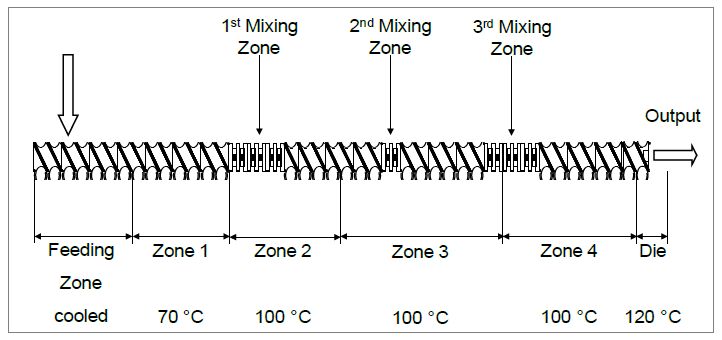
 DownLoad:
DownLoad: 